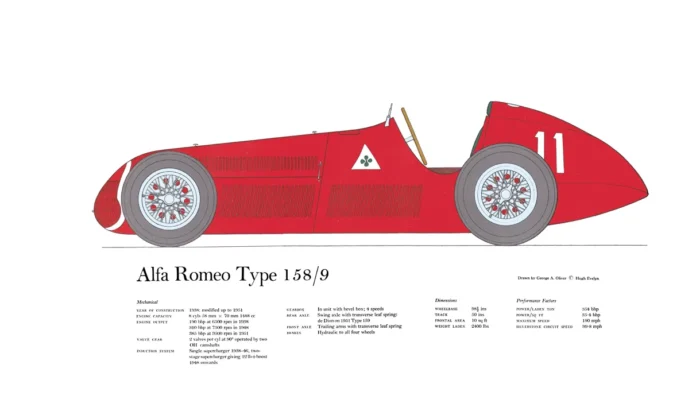Alfa Romeo Type 158/159, Formula 1’s First Winner
Original price was: £25.00.£17.50Current price is: £17.50.
Alfa Romeo Type 158/159 – The Alfetta : winner of the first Formula 1 race and the first Constructor’s Champion in 1950, having first won in 1937
c. 43 x 25.5 cm. (17 x 10 inches)
Details below
In stock
- Satisfaction Guaranteed
- No Hassle Refunds (see Shipping and returns)
- Secure Payments
Description

The Alfa Romeo Type 158/159 (the Alfetta) is one of the most successful racing cars ever produced. The 158 and its derivative took 47 wins from 54 Grands Prix. It dominated Formula 1 at its birth. It won its first race on Leghorn Circuit in July 1937 and its last at the Spanish GP in October 1951. This is equivalent to the last GP event of 2021 being won by a car first successful in 2007. It had started, ironically, with a request by Enzo Ferrari for a car to enter for the 1938 season. Designed at Milan with parts made at Alfa works, it was assembled by Ferrari at Modena who first put the engine on a test bed. It had a 1.5 litre straight-8 supercharged engine made of two blocks of aluminium cylinders with four bores bolted to an aluminium crankcase and a single supercharger.
No one thought the Alfa an ambitious design. In 1946 (after WWII) they won the GP des Nations at Geneva. It now had two superchargers (as did the P3 – which we also have). Power was raised to 254 bhp without raising the crankshaft speed. In the hands of drivers such as Guiseppi “Nino” Farina, Juan-Manuel Fangio and Luigi Fagioli, it dominated for two seasons. In 1947 they were unbeaten with no retirements. By 1950 crankshaft speed was raised to 8500 rpm and power to 350 bhp. The car again won every race. But a serious rival had now appeared: the unsupercharged V 12 from Ferrari. With thrice the cylinder capacity and piston area, this car was a threat. Alfa Romeo stretched the 1.5 litre engine to its limits: crankshaft speed to 10,000 rpm; supercharger pressure to 400 bhp. To counteract the thermal stresses, alcohol fuel mixture was poured into the engine as a coolant which brought fuel consumption below 1½ mpg. Cars were loading 65 gallons (600 lbs) of fuel – more than a third of the unladen weight of the car.
The British GP at Silverstone was the first F1 GP not won by an Alfa. Fangio and Farina both had to stop twice to re-fuel. The Ferrari of José Froilán González won the race, with Fangio second. The Alfa had the edge on performance and with wins in Switzerland, France and Spain, Fangio won his first of five championships that year. But with this weight behind, full power could not be used until the fuel load was reduced. Refuelling every 100 miles, the driver had to exercise restraint two or three times during a race. The 4.5 litre Ferraris were progressively developed to the point that Alfa Romeo acknowledged defeat on the 14th of July 1951 at Silverstone, for the first time in post-war competition. Beaten again at Monza, just a few miles from their own factory, and saved from defeat in Spain only because of tyre failures on the Ferrari, they decided to withdraw at the end of the year. For 27 years Alfa Romeo, which had contributed so much to GP racing for over a quarter of a century, was a works absentee.
Some private Alfa engines were used in F1 in the 1960’s and in the 1970’s Alfa provided support to their works driver, Andrea de Adamich, in his McLaren (1970) and March (1971). None scored championship points. In the mid 1970’s, Alfa designed a flat-12 engine to replace the T33 V8. This took the 1975 World Sportscar Championship. Bernie Ecclestone, owner of the Brabham F1 team, persuaded Alfa Romeo to supply this engine free. In 1977 and 1978 their cars took 14 podium finishes with two wins for Niki Lauda. Alfa finally returned as a works team in 1979. It was a less successful time than the first. Between 1979 and 1985 Alfa works drivers did not win a race and the team never finished higher than sixth in the Constructors’ Championship. The Alfa Romeo logo returned to F1 in 2015 on the Scuderia Ferrari cars. In late 2017, Alfa Romeo announced that they were to become title sponsors for Sauber from 2018. For a recent description of the Alfetta see Motorsport, December 2019.
Additional information
| Dimensions | 43 × 25.5 cm |
|---|




